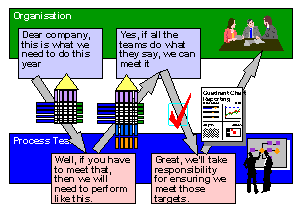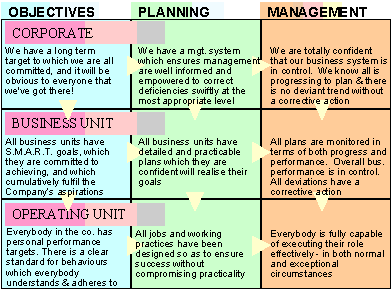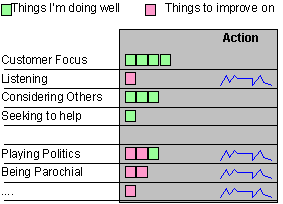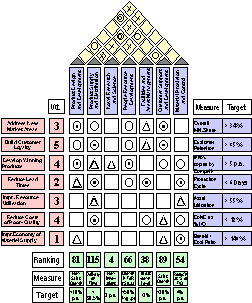 Philosophy
Philosophy
One of the problems with establishing systematic management is the difficulty in identifying and agreeing meaningful performance targets at all levels.
 Quality
Function Deployment (QFD) has helped a number of companies to agree, and
achieve challenging performance improvements at organisation,
department and process level.
Quality
Function Deployment (QFD) has helped a number of companies to agree, and
achieve challenging performance improvements at organisation,
department and process level.
Further than this the same approach can be used to determine, establish and manage behavioural standards to ensure performance targets are achieved.
The diagram to the right is a real example of a company's QFD.
Other tools that help to establish a clear and consistent set of standards, targets and values are:
Visioning, which helps the management team to develop a coherent and inspirational picture of a future that they collectively want to pursue.
Policy Deployment, which enables the cascade of that vision so that people can buy into it by developing their own visions within it.
Reward & Recognition, which, correctly designed, can make real the value set that sees targets and standards as important and will ultimately make the vision a reality
Culture Audit, which provides insight into what the current culture does value, and evaluates the extent to which the current values pursue the vision and targets of the business
Management Competence, is crucial to making the words of your vision, and the numbers in your targets a reality to the people of your organisation...
as is Organisation Design, which can do much to embody the philosophy of the organisation in solid tangible entities
Finally Red/Green Cards provide a means to reinforce the value set where it is most crucial - within the management team.
The above techniques can do much to develop and cascade a consistent value set, focused on the targets and achievements that will ensure business success. Please click on the diagram below (or on the associated text) to explore the various approaches that have been used to deploy a greater sense of 'Philosophy' within organisations.

Organisation Design, Hierarchy of Needs, Red/Green Cards, QFD
 Where
there is no vision, the people perish - Proverbs 29:18
Where
there is no vision, the people perish - Proverbs 29:18
Providing a 'vision' is about creating a clear picture of what the company is working toward - a picture which inspires and guides your people in all of their decisions and actions. The clearer the picture, the more likely that people will work together without confusion. The more inspirational the picture, the more your people will be drawn to give there very best in pursuit of it.
Vision differs from purpose (or mission) in that it represents a future state - something for the business to aspire to (although some visions are actually written in the present tense in order to increase their psychological impact).
An effective vision is one that lives day to day in the hearts of your people. For many companies this may seem idealistic - how can you fire someone up about cleaning toilets? But other companies manage to do exactly that! (Think about Disney!). No matter how difficult it is to make your vision live in your people, the closer you can get to it the better it will work. This will typically require some thinking and practice that may be alien to more traditional managements - for instance: getting people to paint pictures of the future; role playing scenes; organising debates etc.
But at all costs, avoid the vision that goes up on the wall and is rarely referred to again. People will not look at that wall as they are making decisions about their business, but they will be influenced by what is in their hearts and minds.
A good way to start to develop a vision is to gather the management to think about the future and to develop a collective picture of what it is to look like - in words, images, or even a collage of clippings from magazines. And then begin to work these up into clear criteria by which the team can judge success. S.M.A.R.T. criteria provide a clarity that will guide your team to effectively pursue a common endpoint. (See below)
| Specific | Detailed action plan defining precisely what is to be achieved |
| Measurable | Clear criteria by which we can check whether we have been successful |
| Agreed | Owned by both the person who is to meet the objective, and the customers for it |
| Realistic | Practically possible given the constraints and resources available |
| Time based | With clearly defined milestones and dates to be met |
 For your vision to truly
live in the lives of your people, it must be clearly manifest
in the behaviours, decisions and attitudes of your management.
The real PHILOSOPHY of your organisation is set by your management
in their day-to-day responses to situations.
For your vision to truly
live in the lives of your people, it must be clearly manifest
in the behaviours, decisions and attitudes of your management.
The real PHILOSOPHY of your organisation is set by your management
in their day-to-day responses to situations.
PHILOSOPHY concerns what the company values and how - whether that is targets, events or behaviours. For most people in the organisation and in a real and practical sense, what their management values, the company values.
So, what management focuses on, what they ask, how they react to suggestions and situations - these things establish the values and the Philosophy of the organisation. How homogeneous is this within your organisation? What would your people say you value? And is this the same as they would say of your other managers?
In many companies there is clearly a need to appraise managers of the effect they have on PHILOSOPHY and to equip them with the understanding and skills necessary to develop a common, consistent and appropriate value set in line with the company's vision. Relevant training that you might consider in this regard would include courses on leadership and sessions on establishing culture.
 Having established a
clear vision for the company - and having established what that
means in terms of S.M.A.R.T. objectives for the coming years,
it is essential that the management establish clearly what that
means for each of the separate parts of the business.
Having established a
clear vision for the company - and having established what that
means in terms of S.M.A.R.T. objectives for the coming years,
it is essential that the management establish clearly what that
means for each of the separate parts of the business.
The danger here is that either the management set goals and targets for separate departments which they have now ownership for, or separate departments establish their own parochial visions which do little in practice to further the company vision.
Policy Deployment (also known as Hoshin Planning) is an approach which overcomes both of these issues. In Policy Deployment the company develops and communicates a very clear definition of its vision for the coming year, and the reasons why it is important. Individual departments and processes are then left to interpret what these objectives imply for them as a key function within the company (QFD provides extensive help and guidance in this thinking).
 The departments/ processes
work these implications up into a clear proposal for the coming
year, in terms of local performance targets, strategies and resource
implications. The company management then meet to review these
and assess whether collectively the department/process proposals
make achievement of the company vision inevitable. And then they
either go back and renegotiate, or they commission the separate
departments/processes to pursue the targets they have proposed,
and to report on progress.
The departments/ processes
work these implications up into a clear proposal for the coming
year, in terms of local performance targets, strategies and resource
implications. The company management then meet to review these
and assess whether collectively the department/process proposals
make achievement of the company vision inevitable. And then they
either go back and renegotiate, or they commission the separate
departments/processes to pursue the targets they have proposed,
and to report on progress.
In larger companies this process may cascade over a number of levels - from the group into business areas, into individual companies, into departments, and finally into separate working teams or units - but essentially the process is the same between each level,
 Reward and Recognition
is the formal means by which a company establishes its value
set in terms of the behaviours it wants from its people. Done
properly it can be a very powerful way of reinforcing the culture,
but it is nowhere near as powerful as the impact individual managers
have in creating the value set in their area.
Reward and Recognition
is the formal means by which a company establishes its value
set in terms of the behaviours it wants from its people. Done
properly it can be a very powerful way of reinforcing the culture,
but it is nowhere near as powerful as the impact individual managers
have in creating the value set in their area.
Reward and Recognition works by establishing models within the organisation - models of behaviour in terms of publicising why the award is given, and models of response in terms of what people who exhibit those behaviours can expect.
Formal recognition can be achieved in a number of ways, from 'Employee of the Month', through articles in the news letter, and even giving presentations on the subject for which the employee is being recognised to other groups in the company. Informal recognition should be the continuation of this in much smaller, but far more numerous, ways by individual managers explicitly remarking on good things, and saying 'thank you'. The important thing in recognition is to make the reason for the recognition explicit and clear, so that others may learn from it and follow it.
 Reward
is a more difficult subject - essentially it is recognition with
a material benefit attached. But unless it is handled properly
it can create more dissent and resentment than it can aspiration
and learning. The 'reward' has to be selected carefully - if
it is too small, or not related to the personal interests of
the recipient, it can trivialise things (monetary rewards often
do this) - if it is too big, or too infrequent it can lead to
jealousy.
Reward
is a more difficult subject - essentially it is recognition with
a material benefit attached. But unless it is handled properly
it can create more dissent and resentment than it can aspiration
and learning. The 'reward' has to be selected carefully - if
it is too small, or not related to the personal interests of
the recipient, it can trivialise things (monetary rewards often
do this) - if it is too big, or too infrequent it can lead to
jealousy.
Reward systems can be done well, but only by company's that take them really seriously - good well selected non-monetary prizes awarded to a fair percentage of the workforce each year (c.30-60%!!!) for specific things that have been identified and selected fairly, probably by the recipients own colleagues.
 A Culture Audit is a
means of gaining feedback on what the PHILOSOPHY of the organisation
actually is - what targets people are actively pursuing and why,
what the organisation is actually valuing and how.
A Culture Audit is a
means of gaining feedback on what the PHILOSOPHY of the organisation
actually is - what targets people are actively pursuing and why,
what the organisation is actually valuing and how.
In its simplest form it is a matter of someone who will be trusted to keep remarks non-attributable getting out and asking those very questions to a range of people in different parts, and different levels of the business.
However it is possible to develop a more sophisticated approach through using a questionnaire. The questionnaire should give respondents the opportunity to score their part of the company on how well the values are manifest. This approach does assume that there is actually a list of the values that the company wishes to reinforce, so that the questionnaire can be developed.
 The importance of management
in establishing the PHILOSOPHY of the organisation cannot be
overstated. In reading through this section it should be clear
that whatever formal means you use to establish the standards
and values of the organisation has only a fraction of the impact
of management behaviours.
The importance of management
in establishing the PHILOSOPHY of the organisation cannot be
overstated. In reading through this section it should be clear
that whatever formal means you use to establish the standards
and values of the organisation has only a fraction of the impact
of management behaviours.
 In
many cases management may not be fully equipped with the skills
to realise this and do something about it, and it is vital that
this issue, if it exists, is addressed. Training is part of the
answer, but there is also the need to review management competence
on a regular basis, probably through the appraisal system (especially
upward appraisal), and to address any deficiencies through further
training and coaching.
In
many cases management may not be fully equipped with the skills
to realise this and do something about it, and it is vital that
this issue, if it exists, is addressed. Training is part of the
answer, but there is also the need to review management competence
on a regular basis, probably through the appraisal system (especially
upward appraisal), and to address any deficiencies through further
training and coaching.
Specifically the competences you will want to consider are: communication; goal setting; coaching; performance review; leadership.
 Facing South is a simple
exercise which can be used to explore how well values and standards
are set within the organisation. The exercise is in three parts.
Facing South is a simple
exercise which can be used to explore how well values and standards
are set within the organisation. The exercise is in three parts.
Part 1 involves getting the management team to list and consider their answers to the following hypothetical question: "Somebody tells you that to succeed in this organisation you have to have your desk facing south - what conditions would have to pertain at the time for you to believe him/her?"
Part 2 involves the management team considering this question: "You tell somebody that to succeed in this company in terms of progress, pay, job satisfaction, and being helped to achieve your goals, you have to understand the departmental business plan, relate all your objectives and activities to it, and find new ways in which you can make it happen! To what extent will they really believe you?"
Part 3 involves looking at your answers to the first two questions and exploring what you have to do about it?
 Sometimes I find myself
in a situation where I clearly want to turn over a new leaf and
do something different, but all my habits, and the situations
around me, take me down the old paths and away from where I want
to be.
Sometimes I find myself
in a situation where I clearly want to turn over a new leaf and
do something different, but all my habits, and the situations
around me, take me down the old paths and away from where I want
to be.
Companies are like this too, only with them the situation is a lot worse - for them to change their people have to change, and each of their people is a lot like me!
 Alignment
is about looking at the habits (routines) and situations (forums,
events, structures, format) in the company and redesigning them
so that they don't take us down old paths, but down the new one.
Alignment
is about looking at the habits (routines) and situations (forums,
events, structures, format) in the company and redesigning them
so that they don't take us down old paths, but down the new one.
Two tools that will help you think through this are Force Field Analysis, and the Ishikawa diagram. These can be found in the Problem Solving Tools Guide in the Resources section.
The diagram to the right should also help. It models the four questions that you can ask which will help you to design a new policy or practice, and guide the behaviours you want.
 This section is based
on an excellent model proposed by Rummler & Brache in their
book "Improving Performance by Managing the White Space"
This section is based
on an excellent model proposed by Rummler & Brache in their
book "Improving Performance by Managing the White Space"
The model they propose illustrates how the goals of the organisation should be used to establish its design, and how this in turn should guide its management. And how this model cascades down through the various levels of the organisation.
The diagram below shows how the model might be used to explore how well your organisation is set up to establish a comprehensive and consistent value set down through the organisation.

In each cell you might consider how well your current situation aligns with the description given, and how well the links between the various cells work in practice.
 Maslow's Hierarchy of
Needs provides an opportunity for us to consider whether we are
constructing our value set with the right incentives. Maslow's
theory illustrates that there are a number of different levels
of human need. At the bottom there is the need for our Physiological
Needs to be met - such as food, water, air etc. then the needs
progress through the levels of Safety, Social Interaction, Esteem
and ultimately Self-fulfilment.
Maslow's Hierarchy of
Needs provides an opportunity for us to consider whether we are
constructing our value set with the right incentives. Maslow's
theory illustrates that there are a number of different levels
of human need. At the bottom there is the need for our Physiological
Needs to be met - such as food, water, air etc. then the needs
progress through the levels of Safety, Social Interaction, Esteem
and ultimately Self-fulfilment.
Maslow states that we cannot seriously focus on a higher level need while a lower level need is not being met - and is epitomised by the saying "When your up to your butt in alligators it may be difficult to remember that your objective was to drain the swamp".
The theory gives us a basis to explore whether the incentives we are offering our people are attuned to what they need most. We need to link the fulfilment of objectives with the level of needs where we currently are - esoteric arguments don't cut much ice with a person who is having trouble paying their mortgage, and a 5% raise is not the best strategy for someone who is looking for meaning in their life.
![]() Tom Peters used to favour
a phrase "What gets measure gets done". In our work
with clients we have shown this to be true time and time again.
Some things are easy to measure (like output performance) but
others can be a lot more difficult. Not least among these is
the impact of a managers behaviours on the organisation.
Tom Peters used to favour
a phrase "What gets measure gets done". In our work
with clients we have shown this to be true time and time again.
Some things are easy to measure (like output performance) but
others can be a lot more difficult. Not least among these is
the impact of a managers behaviours on the organisation.
And yet these behaviours are the very tool by which a manager fulfils his/her role - they are the essence of what management actually is.
One tool that
has been used to address this is the Red/Green Card scheme. 
In this scheme, the management team starts by defining a set of management behaviours which they collectively believe will take the organisation toward its vision in the most appropriate manner. These they list into a management charter. Typically it includes teamworking behaviours as well as management behaviours.
Each manager also contracts to provide his/her colleagues with feedback against that charter, and does this via red or green cards on which the behaviour is identified, and the effect that it resulted in written down. Green is for a positive example, red for a negative, and each manager is required to distribute 5-10 green cards and 2-5 red cards a month.
The recipients stick the cards in their work areas and use them to monitor their performance in the various areas of the charter, determining the actions they will take to improve on a monthly basis.
 We have found that the
single most effective tool in establishing a clear and consistent
PHILOSOPHY down through the organisation is Quality Function
Deployment (or QFD).
We have found that the
single most effective tool in establishing a clear and consistent
PHILOSOPHY down through the organisation is Quality Function
Deployment (or QFD).
QFD is a means for the management group on an organisation to explore how its objectives are supported by its various operating processes. The diagram on the right illustrates this.
 The objectives (pink
boxes) are listed down the left hand side and their relative
importance identified with a number (1-5, 5 being the most important).
The objectives are further defined in terms of quantified measures
and targets (blue boxes down the right hand side).
The objectives (pink
boxes) are listed down the left hand side and their relative
importance identified with a number (1-5, 5 being the most important).
The objectives are further defined in terms of quantified measures
and targets (blue boxes down the right hand side).
The various key processes in the organisation are listed in the purple boxes along the top of the matrix, and the potential for each to contribute to each objective is considered in the cells of the matrix using a scale of critical (bullseye symbol) major (circle) and significant (triangle). The key value of the QFD is in the discussion that arrives at these conclusions - new insights are gained in terms of the potential for a process to contribute, and new understanding develops about the importance of processes to the company as a whole.
The diagram can also be considered in terms of poorly supported objectives, or processes that add little value to the current strategy.
The symbols can be used in conjunction with the weighting of the objectives to determine a mathematical order for the processes (green boxes at the bottom), and this can be used to stimulate discussion on improvement priorities.
The 'roof' (yellow section) can be used to determine the likely synergy or conflict between processes, and thereby the communication needs between them.
The final diagram also provides a valuable summary of the conclusions, and a basis to communicate them down through the organisation.
© Tesseract Management Systems Ltd 2003
(click below for an oversight)
Case studies of success
Managing by Design
- a handbook of
Systematic Mgt.
(purchase on line)
Transforming performance through QFD
(insight)
Testimonials on systematic management
(for Philosophy)
Overview
Principles
Self-Evaluation